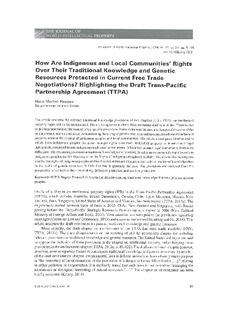| dc.description.abstract | The article analyzes the relevant traditional knowledge provisions of two chapters of the TTPA: on intellectual property rights and on the environment. There is no agreement where these provisions shall be included. There is also wide disagreement over the content of the specific provisions. Some states want to have a widest possible scope of the public domain, and no provisions for sanctioning the taking of genetic resources and associated traditional intellectual property without the consent of indigenous peoples and local communities. The article investigates whether and in which form indigenous peoples are given stronger rights over their intellectual property in international legal instruments, compared to non-indigenous traditional communities. It finds that in many legal instruments, there is no difference. The strongest provisions on traditional knowledge are, however, found in an instrument that applies only to indigenous peoples, the UN Declaration on the Rights of Indigenous Peoples (UNDRIP). The article also investigates whether the rights of indigenous peoples and local communities are stronger in the realm of traditional knowledge than in the realm of genetic resources. It finds that this is generally the case. The provisions are analyzed from the perspective of collective decision-making, defensive protection and positive protection. | nb_NO |
